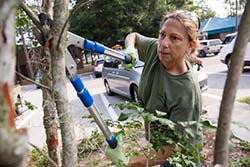Garden Myths, Volume Two
Every pursuit has its myths and legends; gardening is no different. From poisonous poinsettias to homemade pesticides, gardening’s tall tales offer plenty of intrigue.
Here are more of our favorite garden myths, along with the grains of truth that inspired them.
Poisonous Poinsettias (FALSE)

“Poinsettias are not poisonous, although some people are mildly allergic to their white, milky sap.” (Poinsettias at a Glance, Sydney Park Brown)
“As a houseplant, the amount of plant material available for consumption is so small that the species is definitely overrated as a hazard.” (Toxic Plants of North America, 2nd edition, 2013)
That’s all, folks. Like most plants, poinsettias do contain toxins, but not in dangerously high concentrations. You would have to eat a lot of poinsettia to receive a harmfully high dose.
That said, keeping poinsettias out of reach is still a good idea. Sensitivity to chemicals varies by size, age, health, and other factors. Cats and dogs that eat poinsettia may suffer some mild side effects, like diarrhea and drooling. These symptoms are not usually severe enough for a trip to the vet. Poinsettia sap does contain latex, too. Gardeners, children, and pets with latex allergies should avoid handling them. Otherwise, practice common sense and caution and enjoy your holiday poinsettias.
But while we’re talking holiday plants, check your garland and wreathes. Lilies, holly, and mistletoe are all more toxic than poinsettias. These are not a good choice for homes with children or pets. When in doubt, call Poison Control at 1-800-222-1222. For pets, call the ASPCA Animal Poison Control Center at 1-888-426-4435.
Dish Soap Makes a Great Aphid Spray (FALSE)

As tempting as DIY recipes can be, homemade pesticides are dangerous. Very few of these recipes come from research-based sources. In fact, many online recipes are simply “click bait.” They lure you in but offer advertisements rather than sound garden advice.
One very popular home remedy is to dilute dish “soap.” Any soap, even insecticidal soaps labeled for garden use, can injure plants if used incorrectly. Worse still, dish “soaps” are not true soaps. They are detergents, synthetically produced and chemically designed to be powerful cleaners. As degreasers, they can easily destroy a plant leaf’s cuticle. You can learn more in our article “Soaps, Detergents, and Pest Management.”
To protect people and the environment, pesticides are tested by the Environmental Protection Agency (EPA). They are registered and their labels contain specific directions for use. Labels also include precautionary statements, and instructions for storage and disposal. They list relevant environmental, physical, and chemical hazard warnings, such as “hazardous to aquatic invertebrates.” Remember, the label is the law.
Using products not registered by the EPA as pesticides is taking a big risk. We at UF/IFAS do not recommend these mixtures for a number of reasons. The safety hazard to plants, animals, and people are significant. Finally, application of unregistered chemicals onto crops sold as food is illegal.
Painting after Pruning (TRUE but…)
Bretziella fagacearum is a fungus that causes a disease called oak wilt, but this disease is not currently found in Florida. In Texas, where oak wilt is most common, immediately painting pruning cuts is a common practice. The hope is to prevent the insects that spread B. fagacearum from infecting the newly pruned tree. That said, research has yet to show how effective method of prevention is.

In Florida painting fresh cuts is not necessary. In fact, UF/IFAS does not recommend this for any tree species. Healthy trees can seal their wounds on their own. They also have plenty of chemical defenses against disease. If a cut is going to decay, paint will not prevent the process. If moisture gets trapped beneath the paint layer, it may even speed decay.
If you’re serious about avoiding the spread of disease in your garden, we do have some tips. First and foremost, disinfect your garden tools between each plant. Scout often to look for signs of disease. Treat or remove diseased branches quickly. One of the best ways to prevent disease is simply to keep your landscape healthy.
On the subject of trees, we have a bonus myth for you. Did you know that trees are not the same shape below ground as they are above?
To put it another way, the depth of the roots is not the same as the height of the canopy. A better way to imagine the shape of a tree would be to picture a wine glass. The roots, in this picture, are like a coaster underneath. The root zone is usually wide, even wider than the branches above. Especially in Florida, these roots are also often quite shallow.
You can protect the health of your tree by protecting the root zone. Avoid the area beneath the drip-line when you bring vehicles or heavy equipment near trees.
UF/IFAS is Here to Help (TRUE!)

The good news is that the Master Gardener Volunteers are here to help. Contact your county Extension office. Our local Extension staff and volunteers will be happy to offer research-based and time-tested solutions to all your gardening questions.
Also on Gardening Solutions
- Garden Myths, Volume One
- Garden Myths, Volume Three
- Poinsettias
- Soaps, Detergents, and Pest Management
- Disinfecting Your Garden Tools
- Pruning and Maintaining Trees
